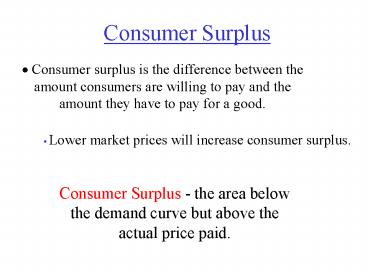Consumer Surplus PowerPoint PPT Presentation
1 / 16
Title: Consumer Surplus
1
Consumer Surplus
- Consumer surplus is the difference between the
amount consumers are willing to pay and the
amount they have to pay for a good.
- Lower market prices will increase consumer
surplus.
Consumer Surplus - the area below the demand
curve but above the actual price paid.
2
Consumer Surplus
Price(monthly bill)
- Lets consider the market for cellular phones.
We will assume the market price is
100.
140
- If the market price is 100, then the 25th
unit will not sell because those who demand it
are only willing to pay 60 for cellular
phone service.
120
100
80
- At 100, the 15th unit will sell because
those who demand it are willing to pay up to
100 for cellular phone service.
60
- At 100, the 10th unit will sell because
those who demand it are willing to pay up to
120 for cellular phone service.
10
15
5
20
25
30
Quantity(of Cell Phone Subscribers)
3
Consumer Surplus
Price(monthly bill)
140
- For all those goods under 15 units, people
are willing to pay more than 100 for service.
120
- The area, represented by the distance above
the actual price paid and below the demand
curve, is called consumer surplus.
100
80
- This area represents the net gains to buyers
from market exchange.
60
10
15
5
20
25
30
Quantity(of Cell Phone Subscribers)
4
Producer Surplus
Price(monthly bill)
- Producer surplus is the difference between the
price at which the seller is willing to sell the
good, and the actual price paid.
Supply
140
120
- If the market price is 100, then the 25th
unit will not be produced because the cost of
supplying it exceeds the market price of
140.
100
80
- At 100, the 15th unit will be produced
because those who supply it are willing to do
so for for at least 100.
60
- At 100, the 10th unit will be produced
because those who supply it are willing to do
so for at least 80.
10
15
5
20
25
30
Quantity(of Cell Phone Subscribers)
5
Producer Surplus
Price(monthly bill)
Supply
140
- For market outputs of less then 15 units,
producers are willing to supply the good for
100.
120
- The area represented by the distance above
the supply curve but below the actual sales
price is called producer surplus.
100
- This area is the difference between the
minimum amount required to induce producers to
supply a good and the amount they actually
receive.
80
60
10
15
5
20
25
30
Quantity(of Cell Phone Subscribers)
6
Tariffs
- Collect a tax on imported good or service
- Why have them?
- To protect certain industries
- Retaliation on restrictions to our trade imposed
by - other countries
- Raise Government revenues
- Lousy politics?
7
Historical Background
U.S.
Average Tariff
60
?
4
?
1930
1996
8
Who gains and loses with a tariff?
1. Small Countries - have no effect on the world
price
2. Large Countries - have an effect on world
prices
9
Norway (price taker)
Ad valorem tariff - of estimated market value
World
Pd
Pw
10
Norway (price taker) - Consumer side
S
change in Consumer Surplus
P
2000
D
Qcomputers
11
Norway (price taker)
Gains/Losses
S
Consumers
-a -b -c -d
P
2000
D
Qcomputers
12
Norway (price taker) - Producer Side
S
P
2000
D
Qcomputers
13
Norway (price taker) - Producer Side
S
Gains/Losses
P
Producers
2000
a
a
D
Qcomputers
14
Norway (price taker)
Gains/Losses
S
Government
Earns importstariff
P
2000
c
D
Qcomputers
15
Ad valorem tariff - of estimated market value
Norway (price taker)
Total Gains and Losses
Consumers -a -b -c -d
Producers a
Government c
Pd
Pw
? Net -b -d
16
Deadweight Losses -b -d
b Over-production loss
b
d Consumption loss
Tariff
d

